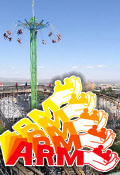Flyover in Chicago takes off with help from FLUX:: SPAT Revolution and JBL Professional
By News Release | July 24, 2024
CHICAGO — At its Spring 2024 opening, Flyover in Chicago became the newest of Flyover Attractions’ immersive indoor flying rides, joining existing installations in Las Vegas; Vancouver, Canada; and Reykjavik, Iceland, that transports guests to the planet’s most epic places through exhilarating flying journeys.
Located within Chicago’s landmark waterfront Navy Pier, the multi-sensory experience, which incorporates leading drone technologies along with impressive aerial shots and first-person narratives, showcases the city from perspectives never seen before. Flyover’s signature Chicago journey is shown on an impressive 65-foot spherical screen with flight motion seats engineered to swoop, dip and turn, giving guests the feeling of flight. The attraction transports 61 guests at a time, with complete sensory immersion using wind, mist and scents, as fliers hang suspended.
The breathtaking ride employs a massive number of audio sources, which are controlled and dynamically spatialized by the advanced audio object and Wave Field Synthesis features of FLUX:: SPAT Revolution immersive audio software, then played through a highly customized system of JBL loudspeakers in a nearly spherical configuration. The FLUX:: software and JBL Professional loudspeakers are supplemented with Crown amplifiers, BSS loudspeaker processing, and control systems from HARMAN Professional, who also supplied extensive support and expertise to the project.
Designing and building an attraction like Flyover is a highly complex undertaking, so the thrilling sonic world of Flyover Chicago is the work of a team of experts from several companies working closely together.
Immersive Entertainment
An extensive presentation occurs primarily in its own immersive theatre, which features a 10-foot diameter, circular “lollipop” screen in the center (serving guests on both sides), plus an elliptical screen wrapping 360 degrees around the audience. Sound designer/mixer Tim Archer of Masters Digital programmed SPAT Revolution to control the soundtrack, which plays through a system designed by Wels, Austria-based Kraftwerk Living Technologies (KLT), who also designed the main flight ride audio system.
Speakers are placed behind the perforated screens, with each side of the venue featuring the same speaker configuration: eight JBL COL800 column loudspeakers inside the lollipop facing out (for a total of 16 cabinets), and six JBL AC18/26 compact two-way loudspeakers behind the wraparound screen (for a total of 12). Low-frequency support is provided by four ceiling-mounted JBL ASB6115 subwoofers.
Crucially, these are not arrays in which every loudspeaker receives the same signal; SPAT Revolution sends a discrete signal to each loudspeaker in order to implement Wave Field Synthesis and other reproduction techniques. Still, a source such as dialogue may need a large contribution of speakers for coverage or perceived sound size reasons, a situation which can create its own problems.
“When you’ve got eight speakers that are not in a simple array and all are receiving the same content, how do you get away with not having comb filtering?” asks Archer. “The answer is that you run the signal through SPAT. I pop one track of dialogue into SPAT and WFS spreads it across the eight columns. And you can be almost around the side of the lollipop before you lose the character of the sound; it’s extremely wide. WFS is killer. It’s a game changer.”
A ring of 10 more AC18/26s mounted above the audience (five on each side of the room) acts as the primary source for presenting the music from composer Elliott Wheeler.
The Main Flight Ride
For the flight ride, guests are seated on one of three separate moving platforms which are vertically “stacked” in the room. Presenting realistic, well-balanced sound to every guest was the biggest challenge facing both Archer and KLT’s Philipp Hartl, responsible for Sales/Lead Audio System Design & Optimisation.
“There are three platforms, and that’s critical. We’re talking about people above, in the middle, and below,” reveals Archer. “That is probably the main thing that makes this mix so unique: traditionally, we are all based in the idea that the person mixing is on the same plane as the rest of the audience. You normally don’t have people located on three different planes.
“But at Flyover Chicago you do, so the guests are having three different experiences. Since everybody doesn’t have the same visual perspective, they should not get the same audio perspective.”
Complicating things further was the sheer number of moving elements, which defined a massive mix process. “I am sitting down with just over a thousand tracks, about six hundred for music and about four hundred and change for sound effects,” Archer reports. Handling this tremendous load required SPAT Revolution to work side-by-side with a second immersive audio system from Encircled Audio.
With the platforms in constant motion, object audio was the only way to place a source and have each person hear it properly. Two guests viewing the same visual element from different platforms need separate mixes that accurately localize the sound for their positions, while the platforms continue to move. Traditional multichannel mixes simply cannot accomplish this. For this reason, localization in SPAT Revolution is not viewed in terms of routing sounds into loudspeakers, but, rather, sending them to “pan points” or virtual speakers to synthesize artificial wavefronts.
What’s more, some musical events relate to visual elements, necessitating moving music sources through space, too. “I’ve got a trumpet player on top of the Wrigley Building, and when the camera flies by him, his trumpet sound has got to whip past us,” Archer details. “Every single thing in the mix moves.” To facilitate this, composer Wheeler and his engineer went to the trouble to deliver the music to Archer already in the form of a SPAT Revolution session.
In his sound system design, Hartl faced the same issue of trying to supply sound appropriately to three continuously moving platforms. “As a practical matter, it’s not possible to achieve the exact same coverage at every seat on each platform,” Hartl explains, “so one of the really tricky things was to find a middle way to tune the speakers that minimized the amount of compromise made at any individual seat.”
Hartl used 34 JBL AM7215-series high power two-way loudspeakers, deployed in four different vertical layers, plus four JBL ASB7128 dual 18-inch subwoofers to furnish prodigious amounts of low-frequency effects. As in the pre-show theatre, SPAT Revolution rendered a different signal feed for each loudspeaker. To ensure clear rear localization, a pair of JBL Control 23-1 ultracompact speakers is mounted on each seat back.
Once the content was generated and the system tuned, the presentation was implemented in a show control system for playback by Miami-based Smart Monkeys.
Teamwork is Key
Bringing such an immensely complex project to a successful conclusion involves plenty of tweaking and problem-solving. As a central contributor to the project, HARMAN gave close support to all the teams involved, with Flux’s Hugo Larin being particularly deeply involved in the design and programming of the immersive audio. “Hugo’s involvement was what got the show across the line,” compliments Eric Sambell, Flyover’s Global Director of Construction and Entertainment. “He was knowledgeable and really jumped in, even with issues that weren’t directly involved with SPAT, like some aspects of design and workflow. It was a really great value-add.”
Teams from Flyover and all of the vendors reported tremendous cooperation and support from all parties, which made a difficult, stressful project actually fun. “It was great to see the different companies work together and not against each other, which was the case at Flyover,” enthuses Hartl. ”We learned from each other, and that was the best thing which could have happened there.”
Archer was just as impressed. “The spirit of collaboration started right with the management of Flyover, who assembled teams of people that could and would work together.”
In the end, of course, the effort is not about the sophisticated systems or even the teams, but providing the guests an amazing experience, as Sambell highlights. “The technology has to be so good that it disappears, like it isn’t even there, so that guests enjoy a seamless experience from the moment they walk in the door to when they walk out afterwards,” he asserts. “We don’t want guests thinking about the technology or where they are, we just want them to be present in what’s happening.”
















